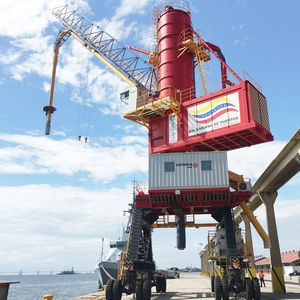

- Company
- Products
- Catalogs
- News & Trends
- Exhibitions
Continuous ship unloader GBU series
Add to favorites
Compare this product
fo_shop_gate_exact_title
Characteristics
- Type
- continuous
Description
The GBU series continuous ship unloader is a kind of continuous ship unloader which can discharge coal, mineral, grain and the other bulk materials. The high efficient operation can speed up the turnover of the vessels and lower the unloading cost.
Genma GBU series continuous ship unloader is a machinery equipment which can discharge coal, mineral, grain and the other bulk materials. The high efficient operation can speed up the turnover of the vessels and lower the unloading cost.
The main body system consists of mechanism and structure.
•The main mechanism: BE lifting mechanism, BE floating telescopic mechanism, BE swing mechanism, disk feeder, boom luffing mechanism, boom swing mechanism, boom belt conveyor and walking mechanism etc.
•The main steel structure: gantry, rotary table, upright boom, equalizing beam, balancing beam, jackstay and pull bar.
•The key mechanism: the cutter-head telescopic mechanism and the swim mechanism.
The rating capacity is 1000-4500TPH. Correspondingly, the vessel capacity crosses from 35000DWT to 400000DWT. The larger the vessel capacity is, the advantage of discharging efficient will be more obvious.
•High efficiency: The average working performance as high as 65%. The remaining material layer is very thin while the continuous ship unloader works independently. The auxiliary work supported by bulldozer accounts for only 10% of the total.
•Environment protection: enclosed conveying, no risk of material leak or loses and dust blowing.
•Energy-saving: stable operation, without frequent starting, braking, slowing down, save more energy for you.
•Low relative investment:the design is based on the maximum capacity and rated capacity.
Catalogs
Product Overview
22 Pages
*Prices are pre-tax. They exclude delivery charges and customs duties and do not include additional charges for installation or activation options. Prices are indicative only and may vary by country, with changes to the cost of raw materials and exchange rates.




